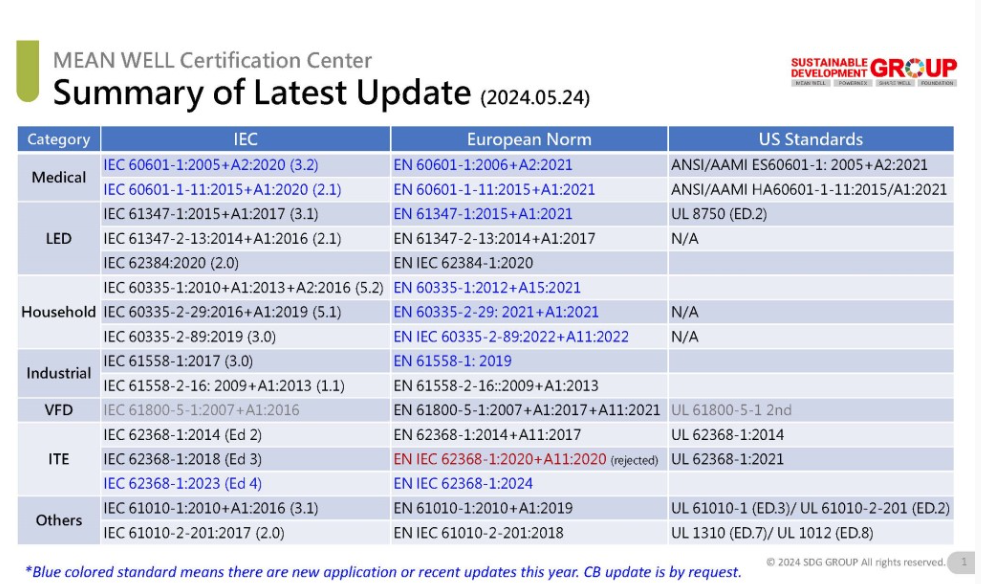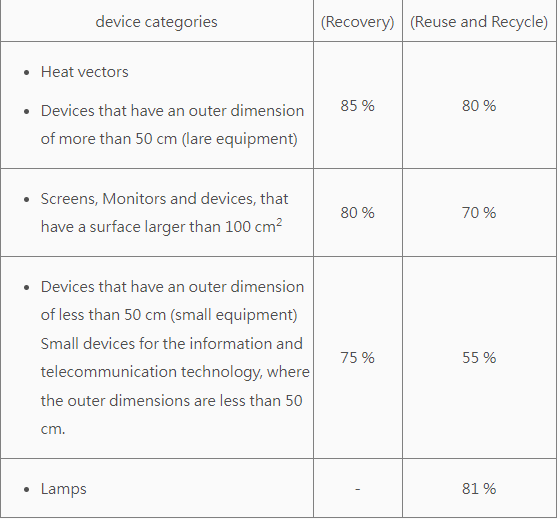
Regulation Aspect
Home
News
FAQ

Product Notice
 Tech Notes
Tech Notes FAQ
FAQ

2024 MEAN WELL safety certification version status


62368 ES PS LPS level and 61558 OVC 60335 list for MEAN WELL product
https://www.meanwell.com/Upload/PDF/62368 ES PS LPS 61558 OVC 60335.pdf

Why the input voltage marked on the spec. sheet is 88~264 VAC while the label on the power supply says that it is 100~240VAC?
Therefore, operating within the broader input voltage range specified in the specification sheet should suffice. The narrower range of input voltage marked on the power supply is to adhere to the safety regulation test standards and ensure that users correctly insert the appropriate input voltage.

Will MEAN WELL's products with CE marking meet the EMC requirements after assembling into my system?
The same switching power supply may exhibit varying results in different environments or applications. Our test results are contingent upon the configuration outlined in the EMC report.

What is ENEC logo? What is the difference between ENEC logo and TUV logo in LED power application?
The scheme is based on the European full certification scheme of ISO-type5, which was initially established in 1991. There are 24 member certification bodies including TUV, VDE, Demko, Nemko participating in the scheme.
At the beginning, it was only applicable to all kinds of lamps and lanterns. With the efforts of European industrial and consumer organizations, the scope of application has covered lighting products and their accessories, switches, controllers, connectors, couplers, plugs, consumer electronic products, audio-visual equipment, information technology equipment, household appliances, safety isolation transformers, electrical appliances, filters and other products.
ENEC is a more competitive enterprise High value reliable verification mark. The new generation LED power of MEAN WELL have apllied for the ENEC mark presently. The code of verification unit will be added after the ENEC mark. For example,ENEC05 represents the ENEC logo issued by DEKRA, and ENEC17 represents the ENEC logo issued by Nemko. The common ENEC codes are as follows.


What is class 2, class II and LPS? What is the difference between class I and class II?
This is accomplished by routing any conductive parts that could otherwise attain hazardous voltages to earth ground in the event of a failure in the basic insulation. Consequently, a Class I surge protective device (SPS) will feature a terminal/pin specifically for earth ground connection.
Class II: Equipment in which protection against electric shock does not rely on basic insulation only, but in which additional safety precautions, such as double insulation or reinforced insulation are provided, there being no reliance on either protective earth or installation conditions. This means a class II SPS does NOT have a terminal/pin for earth ground connection.
LPS: When an electronic circuit is powered by a limit power source (LPS), its output current and power are under the limitation shown in IEC 62368-1 Table Q1, and the risk of fire can be reduced significantly.
Therefore, the safety distances and flammability ratings of the components can be significantly reduced. Consequently, to decrease costs, the plastic enclosures of these power supplies can utilize an HB flammability rating, as specified in the ITE/AV product standard (IEC/EN/UL 62368-1).
Class 2: When powered by a Class 2 electronic circuit, the output current and power are limited according to Table 30.1 in UL 1310, significantly reducing the risk of fire.
Consequently, the safety distances and flammability ratings of the components can be substantially lowered. Hence, to minimize costs, the plastic enclosures of these power supplies can adopt an HB flammability rating, as stipulated in the UL Class 2 power unit standard (UL 1310).

What are the common safety standards in America and Europe If power supply is used in battery charger?

The status for WEEE and MEAN WELL's approach?
For instance, as of August 15, 2018, the obligation has also extended to furniture and clothing or textiles that incorporate electrical functionalities.

One of the most significant changes introduced by the new WEEE Directive 2012/19/EU was the transition to an open scope on August 15, 2018. Consequently, 2018 marks a pivotal point: since then, a considerably larger number of devices have been required to undergo mandatory registration compared to the previous Directive 2002/96/EC.
For instance, as of August 15, 2018, the obligation has also extended to furniture and clothing or textiles that incorporate electrical functionalities.
In accordance with the WEEE regulations, each member country is required not only to provide 3R dismantling reports for products but also to establish a comprehensive recycling system for producers to register within, and ensure timely reporting of statistical results to the Executive Committee.
The aforementioned products typically pertain to END system products. MEAN WELL will persist in furnishing the 3R dismantling report for adaptors and external battery chargers, enabling the system vendor to conduct the final recovery rate assessment.

What is LVLE ? If the power supplies can meet LVLE, what is the benefit for the end product?
a. 0-30Vdc output voltage: Maximum 8 amps
b. 30-60Vdc output voltage: 150/V amps
If the power supplies can meet LVLE , the end product does not need the fire enclosure.

What is MOOP and MOPP?
b. MOPP: provide adequate protection to the patient
c. MOP: only one protection
MW products declare 2xMOPP means that MW product can provide two adequate protections to the patient.
It minimum the risk and also suitable for the patient.